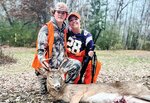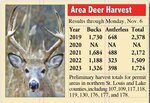Support the Timberjay by making a donation.
Deer harvest slips again
Area deer registrations show hunters are having a bit more success than last year
REGIONAL— Hunters in the North Country mostly struggled to find deer during the opening weekend of the regular firearms deer season, even as there were pockets of relatively good success. …
This item is available in full to subscribers.
Attention subscribers
To continue reading, you will need to either log in to your subscriber account, or purchase a new subscription.
If you are a current print subscriber, you can set up a free website account and connect your subscription to it by clicking here.
If you are a digital subscriber with an active, online-only subscription then you already have an account here. Just reset your password if you've not yet logged in to your account on this new site.
Otherwise, click here to view your options for subscribing.
Please log in to continue |
Deer harvest slips again
Area deer registrations show hunters are having a bit more success than last year
REGIONAL— Hunters in the North Country mostly struggled to find deer during the opening weekend of the regular firearms deer season, even as there were pockets of relatively good success. Overall, however, deer registrations across northeastern Minnesota were down 19 percent over last year’s disappointing numbers and were off a whopping 40 percent over the five-year average.
Not surprisingly, hunter complaints were widespread. “The reports have been coming in,” said Jess Holmes, the DNR’s Tower area wildlife manager. “We’re hearing from camps with eight hunters and just one deer,” she said.
The numbers come as no surprise, said Holmes, who predicted the harvest would be down after last winter’s extended deep snow cover. “What we’re hearing is spot-on with what we expected,” said Holmes, who noted that a string of moderate-to-severe winters has clearly depleted the region’s deer population.
Holmes said she’s heard plenty of complaints from hunters about wolves, and said many hunters reported seeing wolves from their stands. She said the low deer density is likely a factor that’s keeping wolves on the move so they’re more likely to be spotted. “They’re hard-pressed to find food themselves,” she said.
An incident reported by Babbitt-area CO Anthony Bermel suggests that the wolves are taking unusual risks in their quest for food. “One hunter had an encounter with three wolves that ran to his deer shortly after the shot,” stated Bermel in his weekly report. “After getting his deer back from the wolves and field dressing it, the wolves made quick work of the gut pile and then ran down the power line toward the sound of another gun shot.”
While most hunters struggled to find deer, those in the border country near International Falls and those hunting south of the Iron Range reported the most success. Both International Falls-based COs reported some deer camps were reporting a good harvest to date, while others had yet to see deer. That success was evident in the 302 deer registered in PA 107 through Monday, the second highest number of registrations in any of the nine permit areas tracked by the Timberjay. Hunters in PA 178, located south of the Iron Range in central St. Louis County, registered 549 deer through the first three days of the season, the highest of any local permit areas. Those two permit areas accounted for half of the deer registered within the permit areas covered by the Timberjay.
The connection between winter severity and hunter success seems apparent in those results. Both PA 107 and 178 saw some of the lowest snow totals in the region last winter, which likely boosted deer survival in those areas. Indeed, the western half of PA 107 never exceeded a winter severity index, or WSI, of 75, which is indicative of a mild-to-moderate winter. Likewise, the vast majority of PA 178 finished last winter with a WSI reading of under 105, indicating a moderate winter.
Holmes said hunter success has matched up perfectly so far with the WSI maps from last winter. “That’s where you cannot just focus on one thing,” she said. “Our deer population is impacted by winter severity, habitat, and predation.”
Indeed, those areas hit hardest by the conditions last winter were showing lower registration numbers. Hunters in PA 130, which runs from Tower to the south and east, had registered just 48 deer through the first three days. Virtually the entire permit area experienced months of deep snow and ended with a WSI reading well into the “severe” category.
Further north, in PA 119, hunters had registered just 87 deer as of Tuesday morning, a far cry from the registrations that used to come in from that zone, which extends from Lake Vermilion to the border generally east of Hwy. 53 and west of the Vermilion River. That zone used to be home to numerous deer camps, but hunter interest in the area has fallen along with deer numbers in recent years. DNR wildlife managers have pointed to habitat fragmentation from heavy logging as one of the factors limiting deer recovery in that permit area.
Orr area CO Troy Fondie reported many former camps in the area were vacant this year, with the fewest number of hunters he had seen in his career. He reported fielding numerous complaints about the lack of deer and the abundance of wolves.
Hunters in PA 177, which encompasses the Lake Vermilion area west to Hwy. 65, registered 241 deer. That’s fewer than in most recent years, since PA 177, which includes farm country and considerable private land in the Little Fork valley, typically maintains a healthy deer population. But most of the permit area experienced a severe winter in 2022-23, which likely impacted deer survival. Hunters, meanwhile, registered a total of 144 deer in PA 118, and 227 deer in PA 176.
With only spotty, light snowcover for opening weekend, visibility was not as good hunters as in some years. A little more snow fell earlier this week, but milder temperatures could chip away at snowcover in the area ahead of the weekend.
Deer are likely to have little moonlight overnight for the second weekend, as the new moon arrives on Monday. That should limit most deer activity to the daylight hours, which could aid hunters.









